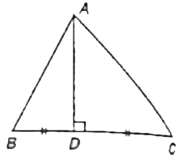AD is internal angle bisector of ΔABC at ∠A and DE perpendicular to AD which intersects AC at E and meets AB in F, then:
EF=4bcb+csinA2
AD=2bcb+ccosA2
AE is harmonic mean of b and c
ΔAEF is an isosceles triangle
The correct Answer is:A, B, C, D
To solve the problem involving triangle ΔABC with the internal angle bisector AD and the perpendicular DE, we will follow these steps:
Step 1: Understand the Configuration
We have triangle ΔABC with AD as the internal angle bisector of ∠A. The line DE is perpendicular to AD and intersects AC at point E and meets AB at point F.
Hint: Visualize the triangle and the points carefully. Draw the triangle and label the points A,B,C,D,E,F accordingly.
Step 2: Use the Angle Bisector Theorem
According to the Angle Bisector Theorem, the ratio of the lengths of the two segments created by the angle bisector AD on side BC is equal to the ratio of the lengths of the other two sides of the triangle:
BDDC=ABAC
Hint: Write down the lengths of AB and AC if they are given or denote them as c and b respectively.
Step 3: Area Relationships
The area of triangle ABC can be expressed as the sum of the areas of triangles ABD and ADC:
Area(ΔABC)=Area(ΔABD)+Area(ΔADC)
Hint: Remember that the area of a triangle can be calculated using the formula 12×base×height.
Step 4: Determine Lengths Using Perpendicularity
Since DE is perpendicular to AD, we can use the properties of right triangles to find relationships between the lengths EF, AE, and AD.
Hint: Use the Pythagorean theorem in triangles ADF and ADE to find the lengths.
Step 5: Harmonic Mean
To find the harmonic mean of the segments AE and EF, we use the formula for the harmonic mean:
HM=2⋅AE⋅EFAE+EF
Hint: Ensure you have the lengths of AE and EF calculated before applying this formula.
Step 6: Analyze Triangle AEF
Finally, analyze triangle AEF to find any additional properties or relationships that may be useful, such as angles or side ratios.
Hint: Check if triangle AEF has any special properties (like being right-angled) that can simplify your calculations.
Conclusion
By following these steps, we can systematically analyze the triangle and find the required lengths and relationships. Make sure to keep track of all the relationships and properties of the triangles involved.
We have triangle ΔABC with AD as the internal angle bisector of ∠A. The line DE is perpendicular to AD and intersects AC at point E and meets AB at point F.
According to the Angle Bisector Theorem, the ratio of the lengths of the two segments created by the angle bisector AD on side BC is equal to the ratio of the lengths of the other two sides of the triangle:
BDDC=ABAC
The area of triangle ABC can be expressed as the sum of the areas of triangles ABD and ADC:
Area(ΔABC)=Area(ΔABD)+Area(ΔADC)
Since DE is perpendicular to AD, we can use the properties of right triangles to find relationships between the lengths EF, AE, and AD.
To find the harmonic mean of the segments AE and EF, we use the formula for the harmonic mean:
HM=2⋅AE⋅EFAE+EF
Finally, analyze triangle AEF to find any additional properties or relationships that may be useful, such as angles or side ratios.
By following these steps, we can systematically analyze the triangle and find the required lengths and relationships. Make sure to keep track of all the relationships and properties of the triangles involved.
Topper's Solved these Questions
- PROPERTIES OF TRIANGLES BOOK - ML KHANNACHAPTER - PROPERTIES OF TRIANGLES EXERCISE - Problem Set (1)(TRUE AND FALSE)
3 Videos
- PROPERTIES OF TRIANGLES BOOK - ML KHANNACHAPTER - PROPERTIES OF TRIANGLES EXERCISE - Problem Set (1)(FILL IN THE BLANKS)
10 Videos
- PROGRESSIONS BOOK - ML KHANNACHAPTER - PROGRESSIONS EXERCISE - MISCELLANEOUS EXERCISE (ASSERTION/REASON)
1 Videos
- RECTANGULAR CARTESIAN CO-ORDINATE SYSTEM AND THE STRAIGHT LINEBOOK - ML KHANNACHAPTER - RECTANGULAR CARTESIAN CO-ORDINATE SYSTEM AND THE STRAIGHT LINEEXERCISE - COMPREHENSION
11 Videos
Similar Questions
Internal bisector of ∠A of triangle ABC meets side BC at D. A line drawn through D perpendicular to AD intersects the side AC at E and the side AB at F. If a, b, c represent sides of ΔABC, then
View SolutionIn ΔABC, the bisector of ∠A interseats BC at D. A perpendicular to AD from B intersects AD at E. A line segment through E and parallel to AC intersects BC at G and AB at H. If AB = 26, BC = 28, AC = 30. Find the measure of DG.
View Solution
Knowledge Check
If AD is the internal angle bisector of ΔABC with AB = 3 cm and AC = 1 cm, then what is BD : BC equla to ?
A1:3B1:4C2:3D3:4AD is perpendicular to the internal bisector of ∠ABC of triangle ABC. DE is drawn through D and parallel to BC to meet AC at E. If the length of AC is 12cm. Then the length of AE (in cm) is.
A3B8C4D6In ΔABC, internal angle bisector of ∠A meet side BC in D. DE⊥AD meet AC in E and AB in F. then
AAE in H.M of b and cBAD=2bcb+ccos.A2CEF=4bcb+csin.A2DΔAEF is isosceles
AD is perpendicular on angle bisector of ∠ABC of ΔABC. A line DE from D is parallel to BC where it meet AC at E. If AC = 12 cm. then find AE.
View SolutionIn ΔABC, angle bisector of ∠A intersect BC at D and intersects circumcircle of triangle at E then.
View SolutionIn a ΔABC,AD is a median. The bisectors of ∠ADBand∠ADC meets AB & AC at E and F respectively . AE:BE=3:4 . Find EF:BC.
View SolutionLet AD be the angle bisector of ∠A of ΔABC such that AD=αAB+βAC, then
View SolutionIn the adjoning figure of ΔABC,AD is the perpendicular bisector of side BC. The triangle ABC is :

View Solution
